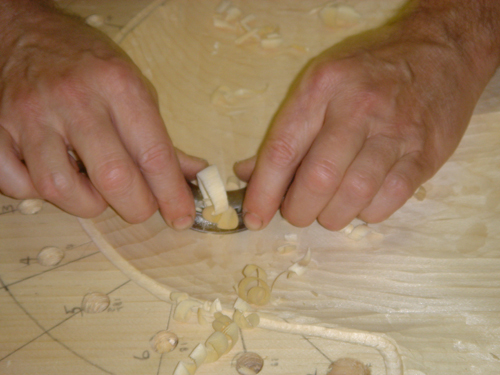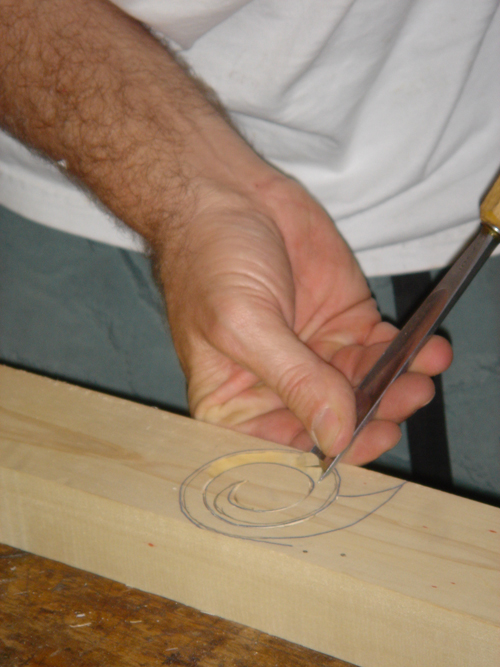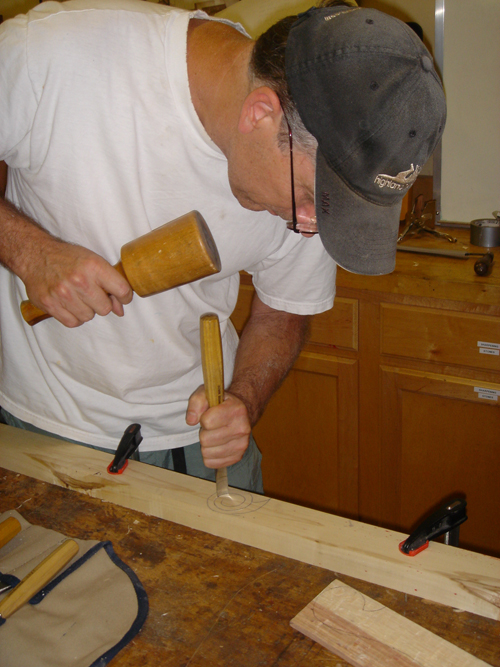
Arthritis is a nearly inevitable consequence of aging in humans. For many human males, it seems
the desire to do some woodworking is also. (There are some great women woodworkers, but their
interest doesn’t seem to be timed with graying hair as much as men’s). For most of us there is no
need for a conflict between these two traits. There are many things the modern woodworker can do to
minimize the impact of woodworking on one’s arthritis and to also minimize the impact of arthritis
on woodworking.
First make sure it is acceptable for you to do woodworking. If there is any question, you should call, write
or fax your doctor to make sure working with wood is safe for you. An office visit is probably not
necessary, but communication is. Generally it is perfectly safe, but there are exceptions. Some
arthritic joints need to be treated very delicately and so restrictions could apply. Lifting
anything heavy may be forbidden. Fortunately there is a work around for restrictions.
Use of power tools may be restricted or even forbidden if you are taking certain medications.
That is not as serious as it sounds as medications can be changed and even if they cannot, anything
that can be done with a power tool can be done with hand tools. Chris Black, who worked at Highland
for many years, said if he was only making one of something he could do it just as fast with hand
saw and hand planes as could be done with power tools. Watching him with hand tools is a joy.
After you are sure it is safe to go on remember there are several things you can do to make
woodworking safer and more enjoyable. Generally there are no new “rules” but the common sense
procedures that are part of the craft are important for additional reasons.
Sharp knives and good coffee

My father worked for the concrete industry and traveled throughout the Southeastern United
States. There is probably no city he did not visit. Having dined in hundreds of restaurants he
said that the secret to a good restaurant is sharp knives and good coffee. The sharp knives are to
cut the tough meat and the coffee was to enjoy after the meal. Woodworking is no different. With
arthritis, your hand tools and power tools must be very, very sharp. Dull tools are not only
unpleasant, but dangerous. A dull chisel must be hit much harder to do its task, which then causes
additional stress on the hand and an increased likelihood that the tool will leave the wood in an unpleasant
manner. A dull band saw or circular saw blade also needs more force to cut. Pushing hard on a
power tool is not acceptable. Dull router bits are unsafe, unpleasant to use and produce poor
cuts.
Let’s talk about power tools first. Keep blades clean and monitor their wear. Follow the
manufacture’s recommendations before examining the blades and cutters and always unplug the tool
before doing anything. Often a circular saw blade will seem worn when it is only clogged with oil,
sap etc. Blade and bit cleaners are useful for getting your blades clean. An old tooth brush and
household cleaner will also work. My band saw blades just seem to wear out, but a good inspection
periodically is really recommended. Some cleaning might help. Between inspections, attend to your
power tool’s cutting speed, vibration and quality of cuts. Poor cutting results often indicate
maintenance attention is needed.
Quality circular saw blades can be sharpened. Forrest, one of the more popular blade
manufactures, has a mail-in sharpening service. A back up blade is needed to stand in till the
mailed in blade returns. Fred Crudder, a friend who is a professional cabinet maker, sends his new
blades in for sharpening after about 40 hours of service. In addition to his meticulous attention to
sharp blades, Fred spends a lot of time to set up his saws. The results are evident as they produce
phenomenal cuts.
Some band saw blades can be sharpened as can router bits, however, the cost is often so high that
you may be better off with outright replacement. Poor performance is an indicator of dulling. Inspect,
inspect, inspect.
It is critical to keep joiner and thickness planer knives sharp. Thickness planer blades just
seem to dull slowly. If you are not careful, they get dull without you noticing. The planer
feeds slower and you must take thinner cuts. Joiner blades, at least mine, seem to go quickly when
they go. First symptom of joiner blade problems for my joiner is the edges just not coming out
right. I just can’t get a good straight edge. When you first notice a problem with your joiner, I
suggest you check the knives.
Some joiner and planer knives can be sharpened and others must be replaced. You can send your
blades out for sharpening or purchase the equipment and do it your self. I have a Makita horizontal
water stone sharpening system and the Tormek vertical wheel. I will use either one depending on my
mood that day. I find it nice to be able to sharpen them when I need to. There is a learning curve.
Initially it took some time to get things right, but now it takes only about an hour to sharpen the
blades and get them back on and adjusted. Joiner and thickness planer blades could be sharpened by
hand, however I know of no one who does. Regardless of your method, consider a second set of knives
so it will not stop the shop. If you have that spare set, and they are sharp, if a problem occurs
all you have to do is replace the set on the machine.
Having sharp hand tools is extremely important especially for those of us with arthritis. Luckily
a dull hand tool tells you very quickly that it needs attention. Hand tool sharpening can be done
in any shop. The system can be as simple or as complex as one chooses. I believe hand plane blades
are the most critical. I use a blade holding guide and either water stones or wet dry sand paper on
a granite tile. Both systems work exceptionally well. I am developing my skills with both and do
not have a favorite. Lie Neilson reps prefer the water stones as they can be taken to a much higher
grit. Badly nicked blades should probably be sharpened on granite first as it resolves the issue of
reshaping a wet stone. The cryo-hardened blades are great, but probably should be sharpened on a
machine. I started one by hand once then switched to a machine!
When sharpening by hand, beware of the stress on your hands. Be gentle. Sharpening jigs are
very helpful and really reduce the stress on my hands. If you have to press down too hard, go to a
coarser grit. Move up grits in as fine of step as you can.
I usually sharpen chisels on a Tormek sharpener. It is fast and very good. For working on
guitar bracings I will hand sharpen my tools to a mirror edge, but typically a good power sharpener
will do just fine.
A dull hand saw is really infuriating. Hand sharpening hand saws is a dying art. However it is
not that difficult and there are several books on the subject. The tools you need are not expensive
and the process of sharpening a saw can be quite satisfying. A freshly sharpened Danish saw is really a joy to
use. I "fiddle around" with the blade set for the wood and cuts I am doing. It is not only worth
the effort, it also provides you with some nice bragging rights when talking shop.
Power tool set up – the second part of sharpening. If you have a sharp blade and the tool is set
up wrong it will not work well and may be dangerous. An improperly set up table saw is more likely
to have a kick back issue or just be harder to use. An improperly set up jointer causes mental
illness. Take your time and do it right and check things often. Your first source of information
is the instruction manual that came with your power tools. Also check the manufacturer’s web site.
They are especially helpful if you lost the manual. In addition to the manuals there may be updates
and/or recall notices. Follow their instructions. There are also many after market books available
about set up that cover some extra tricks. There are jigs for joiner knives. However you set up,
it is important to do it right. All safety equipment must be on and working perfectly. Feed screws
must be clean and lubricated with a lubricant that the manufacturer recommends. My saw was so hard
to adjust that it really hurt my hands to set the depth right. I followed my own advice and cleaned
it. Take your time to set up the tools. It is worth the effort.
Power vs. hand tools

This is always a personal preference issue. There is no right answer. However, I can listen to
the radio while using hand tools and the dust is not as bad. Also, moving a table saw around the
shop can take some strength. A Japanese hand saw weighs a few ounces. I have never heard of
anyone hurting their back while lifting one. Depending on the day, I will use one or the other.
Don’t assume that hand tools are automatically safe. Wear eye protection and follow good
procedures. Read available books for instruction. Also be very careful not to drop them. My 2 inch carving
chisel is sharp and heavy enough that if it fell off the bench and hit my foot I suspect there would
be a trip to the emergency room.
An acquaintance moved his shop. His planer was three phase electrical and his new shop was not.
He had to do his thickness planning by hand for a while and as a result, his chronic shoulder pain
went away. While his case may be unique, with proper hand tool use, especially hand planes, you can
get a nice upper body workout.
Oh right, and the coffee. This may be the most important part – slow down. If you are in a hurry, then just
change your deadline. Think of every cut and operation before you do it. Using a hand or power
tool is like playing a guitar or piano – hand position is critical. It should never strain your
hand to use a power tool or hand tool. If it does, then take a coffee break and think of a better
way. More on this in part two – A man should have some vices.
